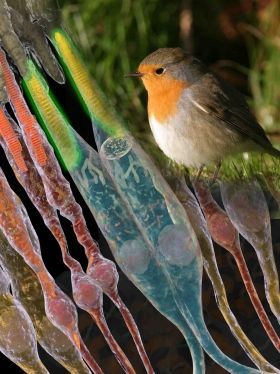Migratory birds travel long distances when they shift between breeding and wintering grounds.
Observations of migrating birds were first recorded by ancient Greeks more than 3,000 years ago, and it has long been one of Natures’ great mysteries how they find their way when embarking on thousands of kilometers long journeys.
In 2000 researchers suggested that a protein in the birds’ eye helps them take information from light and process it to a travel course: an inner magnetic compass. Since then the basic sensory mechanisms underlying this magnetoreception has remained elusive.
Read more at University of Southern Denmark
Image: Researchers have discovered that the long sought after protein in migratory birds are situated exactly here at the outer segment of the so-called double cone photoreceptor cells in the retina of the bird (this is a European robin). Cry4 is unique to birds and therefore could endow them with the sixth sense. (Credit: Ilia Solov'yov/SDU)


